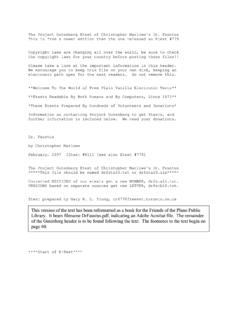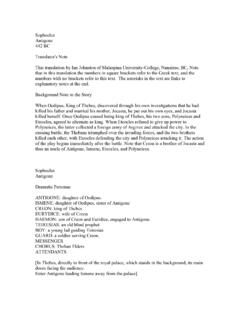Transcription of Introduction: “We must live independent or die”: The ...
1 1 Introduction: We must live independent or die : The haitian declaration of independence in atlantic Context David Armitage, Harvard University, and Julia Gaffield, Georgia State University For the New-York Historical Society s Revolution! The atlantic World Reborn exhibit in 2011-2012, curators Richard Rabinowitz and Lynda B. Kaplan commissioned a miniature sculpture of the Palace of Versailles from artists Mart n Avila and Benita Rodriguez Alvarez of Guanajuato, Mexico. The artists created a desktop-sized palace constructed entirely of sugar tinged with vegetable dyes. Their message was crystal clear; as Rabinowitz explained, the sculpture emphasized that the French Empire was in some ways a kingdom based on sugar.
2 1 Indeed, an estimated 30% of France s wealth in the 18th century came from its colonies, especially Saint-Domingue, the atlantic World s most wealth-producing colony and one of the richest spots on the face of the earth. This modern sugar sculpture echoed another that had been created just over two hundred years earlier to mark the second anniversary of haitian independence on January 1, 1806. At Cap Ha tien, the independence celebrations had comprised a military review, a reading of the declaration of independence , and a high mass; in Gona ves later that day, Jean-Jacques Dessalines laid on a commemorative feast attended by the leading officers, military and civil, of the infant state.
3 A horrified American visitor reported that, after dinner, a piece of confectionary in imitation of the skeleton of a white man, was served upon the table. The object in was no doubt, upon that day of national jubilee, to excite and cherish in the minds of the chiefs, their hatred of the French, by exhibiting to their sight such expressive symbols as could not fail to call Forthcoming in Julia Gaffield, ed., The haitian declaration of independence (Charlottesville: University of Virginia Press, 2015). 1 New-York Historical Society Museum and Library, Revolution!
4 The atlantic World Reborn, ; ; see also the catalog for the exhibit: Thomas Bender, Laurent Dubois, and Richard Rabinowitz, eds., Revolution! The atlantic World Reborn (New York: D. Giles Ltd, 2011). 2 to their recollection, the remembrance of their past deeds. 2 What better way to remind the victors of their triumph than this macabre effigy of their former masters? And what more appropriate material for its construction than the sugar that had once been grown with their sweat and blood? To mirror that historic confection, Avila and Alvarez might have tinted their modern sculpture with blood instead of vegetable extract such a morbid touch would have reminded viewers that France s palatial opulence was shot through with untold suffering and death.
5 Haiti was often called the pearl of the Antilles, but that whitewashed metaphor ignored the massive human price that millions of enslaved men and women paid to slave traders, plantation owners, merchants, and government agents to enable their wealth. The colonial and slave systems in the Caribbean characteristically worked the slaves to death; it was more cost-effective to replace them. Saint-Domingue achieved its status as the atlantic s richest colony because slave traders and plantation owners purchased and imported people from west and west-central Africa and forced them to work as slaves on sugar and coffee plantations.
6 The colony produced other goods such as indigo, cacao, and mahogany, but coffee and sugar were the real moneymakers. Pre-revolutionary Saint-Domingue fostered a life-crushing labor system but at the same time provided unique opportunities for the development of an economically and socially rich class of gens de couleurs. Free people of color also lived in other American colonies, but their political and social strength and number made the situation in Saint-Domingue The overwhelming majority of the population, however, was enslaved and an estimated two thirds of 2 Memoirs of Hayti.
7 Letter XVIII (February 1806), The Port-Folio, 5, 3 (March 1811): 246; Erin Zavitz, Performing Revolution: Jean-Jacques Dessalines and haitian independence Day, 1804-1904, p. 000 below. 3 John D. Garrigus, Before Haiti: Race and Citizenship in French Saint-Domingue (New York: Palgrave Macmillan, 2006). 3 the enslaved population on the eve of the haitian Revolution was Jean Casimir calls these people captives to better describe the process through which they were violently removed from their Of the estimated 500,000 slaves in Saint-Domingue in 1791, nearly 240,000 had been imported to the colony since 1780.
8 The high mortality rate spurred the continued importation of increasing numbers of African captives: 40,000 captives alone were imported in 1791. The result was that, on the eve of the haitian Revolution, it is possible that as many as 180,000 enslaved men and women had arrived in the previous five years, and half of them may have only been in the colony for a very short time. Most of these African captives came from the regions east of the Kingdom of Congo and south of the Congo And, while most came from the same region in central Africa, they were linguistically and culturally diverse.
9 This diversity was layered onto racial, legal, and regional differences within Saint-Domingue. The population that would eventually become haitian citizens, therefore, was heterogeneous, often in conflict, and with distinct and disparate goals in the context of the unfolding Revolution. The first attack on the immensely profitable colonial system came in 1789 when free people of color began to agitate for equal rights as free men. This battle for full French citizenship sometimes turned violent since the established colonial state did not welcome this challenge to the discriminatory social-racial hierarchy that kept whites in power.
10 Events in Europe, however, and especially the publication of the declaration of the Rights of Man and of the Citizen, made it increasingly difficult for the colonial elite to justify the subversion of about half the free population in the colony. 4 John K. Thornton, African Soldiers in the haitian Revolution, The Journal of Caribbean History, 25, 1 (1991): 59, citing David Geggus, Sugar and Coffee Cultivation in Saint Domingue and the Shaping of the Slave Labor Force, in Ira Berlin and Philip Morgan, eds., Cultivation and Culture: Work Process and the Shaping of Afro-American Culture in the Americas (Charlottesville: University Press of Virginia, 1993); Thornton, " I Am the Subject of the King of Congo : African Political Ideology and the haitian Revolution," Journal of World History 4, 2 (1993): 181-214.



















